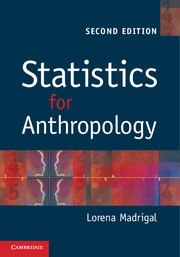Book contents
- Frontmatter
- Contents
- List of partial statistical tables
- Preface
- 1 Introduction to statistics and simple descriptive statistics
- 2 The first step in data analysis
- 3 Probability and statistics
- 4 Hypothesis testing and estimation
- 5 The difference between two means
- 6 The analysis of variance (ANOVA)
- 7 Non-parametric tests for the comparison of samples
- 8 The analysis of frequencies
- 9 Correlation analysis
- 10 Simple linear regression
- 11 Advanced topics in regression analysis
- References
- Index
Preface
Published online by Cambridge University Press: 05 June 2012
- Frontmatter
- Contents
- List of partial statistical tables
- Preface
- 1 Introduction to statistics and simple descriptive statistics
- 2 The first step in data analysis
- 3 Probability and statistics
- 4 Hypothesis testing and estimation
- 5 The difference between two means
- 6 The analysis of variance (ANOVA)
- 7 Non-parametric tests for the comparison of samples
- 8 The analysis of frequencies
- 9 Correlation analysis
- 10 Simple linear regression
- 11 Advanced topics in regression analysis
- References
- Index
Summary
The first edition of this book was published 13 years ago, and much has changed since that time. To put it directly, the first edition of Statistics for Anthropology became terribly old-fashioned. When I wrote the first edition it made sense to discuss rounding-off rules, and to dedicate an entire chapter to the computation of frequency distributions. In the year 2012 it does not make any sense to devote time to these topics, as most students will be using a computer package which will easily round the numbers and compute the frequency distributions for them. I have also decided to dedicate very little time to the production of graphs because this is something that college students learned in their pre-college education, and which is easily done with many computer programs. At the same time, I augmented the book by including several issues that were missing in the first edition: the Poisson distribution, two-way ANOVA, the odds ratio, Fisher's exact test, Kendall's tau, and an entire chapter on advanced regression topics. In addition, and to reflect current practice, I have expanded my discussion on probability as to facilitate an understanding of maximum likelihood and Bayesian approaches to statistical inference, as well as to classical hypothesis testing. However, most of the book focuses on the latter, which is still the most frequent approach used in anthropological quantitative analysis. There are specialized books on maximum likelihood and Bayesian approaches which should be consulted for more in-depth discussion on maximum likelihood and Bayesian statistics.
Although this edition is going to be more advanced than the first one, it does not intend to give students their entire statistical education! Instead, this textbook will cover important univariate techniques. Students wishing to learn multivariate statistics need to take a second-level course.
- Type
- Chapter
- Information
- Statistics for Anthropology , pp. xiii - xivPublisher: Cambridge University PressPrint publication year: 2012

